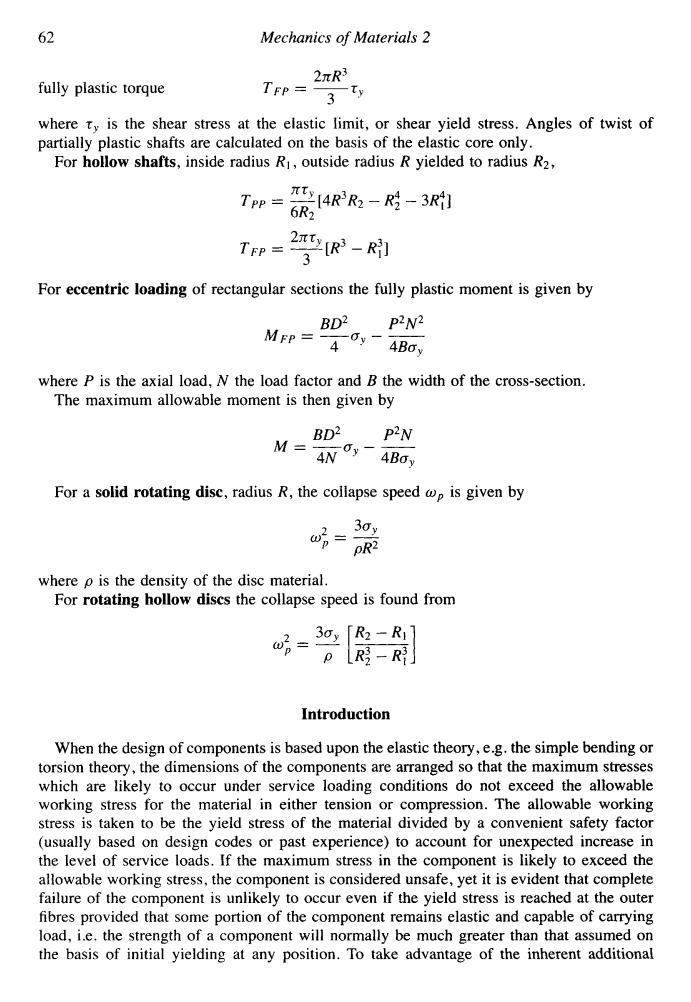正在加载图片...

62 Mechanics of Materials 2 2πR3 fully plastic torque Tre=3-ty where ty is the shear stress at the elastic limit,or shear yield stress.Angles of twist of partially plastic shafts are calculated on the basis of the elastic core only. For hollow shafts,inside radius R1,outside radius R yielded to radius R2, Tpe= 4RR2-R号-3R1 R2 2t (R-R] TFP =3 For eccentric loading of rectangular sections the fully plastic moment is given by BD2 P2N2 MFP=4 0y-ABay where P is the axial load,N the load factor and B the width of the cross-section. The maximum allowable moment is then given by BD2 P2N M= 4N0,-4Ba) For a solid rotating disc,radius R,the collapse speed p is given by 30y 2= PR2 where p is the density of the disc material. For rotating hollow discs the collapse speed is found from wp 303 [R2-Ri LR-R」 Introduction When the design of components is based upon the elastic theory,e.g.the simple bending or torsion theory,the dimensions of the components are arranged so that the maximum stresses which are likely to occur under service loading conditions do not exceed the allowable working stress for the material in either tension or compression.The allowable working stress is taken to be the yield stress of the material divided by a convenient safety factor (usually based on design codes or past experience)to account for unexpected increase in the level of service loads.If the maximum stress in the component is likely to exceed the allowable working stress,the component is considered unsafe,yet it is evident that complete failure of the component is unlikely to occur even if the yield stress is reached at the outer fibres provided that some portion of the component remains elastic and capable of carrying load,i.e.the strength of a component will normally be much greater than that assumed on the basis of initial yielding at any position.To take advantage of the inherent additional62 Mechanics of Materials 2 fully plastic torque where ty is the shear stress at the elastic limit, or shear yield stress. Angles of twist of partially plastic shafts are calculated on the basis of the elastic core only. For hollow shafts, inside radius RI , outside radius R yielded to radius R2, =tv 3 4 Tpp = -[4R R2 - R2 - 3R:] 6R2 For eccentric loading of rectangular sections the fully plastic moment is given by BD2 P2N2 4 4Bav MFp = -ay - - where P is the axial load, N the load factor and B the width of the cross-section. The maximum allowable moment is then given by BD~ P2N 4N 4Bo, Mz-0 -- For a solid rotating disc, radius R, the collapse speed wp is given by where p is the density of the disc material. For rotating hollow discs the collapse speed is found from Introduction When the design of components is based upon the elastic theory, e.g. the simple bending or torsion theory, the dimensions of the components are arranged so that the maximum stresses which are likely to occur under service loading conditions do not exceed the allowable working stress for the material in either tension or compression. The allowable working stress is taken to be the yield stress of the material divided by a convenient safety factor (usually based on design codes or past experience) to account for unexpected increase in the level of service loads. If the maximum stress in the component is likely to exceed the allowable working stress, the component is considered unsafe, yet it is evident that complete failure of the component is unlikely to occur even if the yield stress is reached at the outer fibres provided that some portion of the component remains elastic and capable of carrying load, i.e. the strength of a component will normally be much greater than that assumed on the basis of initial yielding at any position. To take advantage of the inherent additional